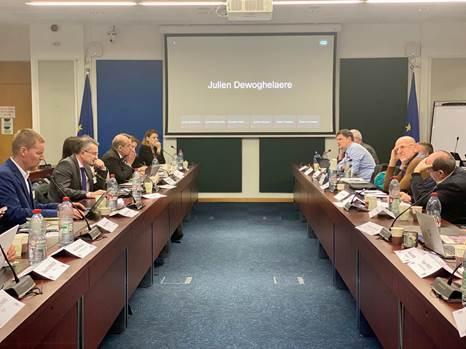ASNR participates in a round table organized by the European Commission and Greenpeace on the application of the Aarhus Convention and the Nuclear Safety Directive
On 21st and 22nd January 2025, ASNR, represented by Christophe Quintin (Chief Inspector, member of the Executive Committee), Luc Chanial (International Advisor to the Executive Committee) and Fanny Pigot (Business Manager, International Division), was in Luxembourg to participate in a round table on the Aarhus Convention.
Organized by the European Commission (DG ENER) and Greenpeace, this round table looked at “Implementation of the Nuclear Safety Directive (NSD): transparency, public participation and the role of civil society in the independence of nuclear regulation”.

The round table brought together members of ENSREG (European nuclear safety regulators group), ANCCLI (French national association of local information commissions), Greenpeace, NTW (Nuclear Transparency Watch), EEB (European Environmental Bureau) and other European non-governmental organizations, several nuclear safety authorities (Belgium, Hungary, Portugal, Czech Republic, Sweden and Slovakia), and legal experts. It was an opportunity for participants to discuss challenges and best practices for compliance with the three pillars of the Aarhus Convention: access to information, public participation, and access to justice in environmental matters.
The first day was devoted to the practical application of public participation in decision-making in the nuclear field. After introductory remarks by the organizers, the European Commission (by presenting the 2nd report from DG ENER assessing the application of the NSD by member countries), the Convention's Implementation Committee (ACCC) and the Österreichisches ÖkoInstitut (Austrian Research Institute) shared their thoughts on the possibility for regulators and operators to act as facilitators of public participation.
The regulators were then invited to present concrete examples of public participation procedures they have implemented at a national level. Christophe Quintin highlighted ASNR's initiatives to increase public involvement in its resolutions in France. He illustrated his remarks by presenting the approach taken by ASNR as part of the consultation workshops held in preparation of referrals from the former IRSN and the standing expert groups to assess the construction license application for the Cigéo disposal facility project.
The second day focused on transparency and public access to information. Based on real-life examples from a number of non-governmental organizations, there was a discussion on the practices implemented by the nuclear safety authorities present to inform the public. In addition to the actions taken by ASNR in response to a regulatory requirement, Luc Chanial presented a number of initiatives of ASNR, or initiatives to which ASNR has contributed, to reinforce public information and transparency on its activities. In the field of radiation protection, he noted the introduction in 2008 of the ASNR/SFRO scale for informing the public about radiation protection events affecting patients undergoing external beam radiotherapy and brachytherapy procedures. In the field of nuclear safety, he mentioned the public consultation process on the safety provisions proposed by EDF for the continued operation of its 1,300 MWe nuclear reactors, launched by the French High Committee for Transparency and Information on Nuclear Safety (HCTISN), to which ASNR contributed.
In a number of cases, several non-governmental organizations reported difficulties in obtaining the requested information from the safety authorities concerned, and described the legal action they have taken as a result. Finally, the limits of providing information, in terms of security and data confidentiality, were widely debated.
